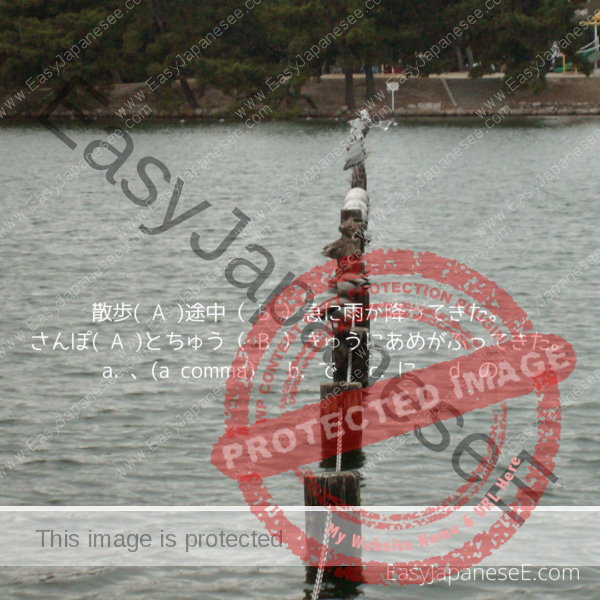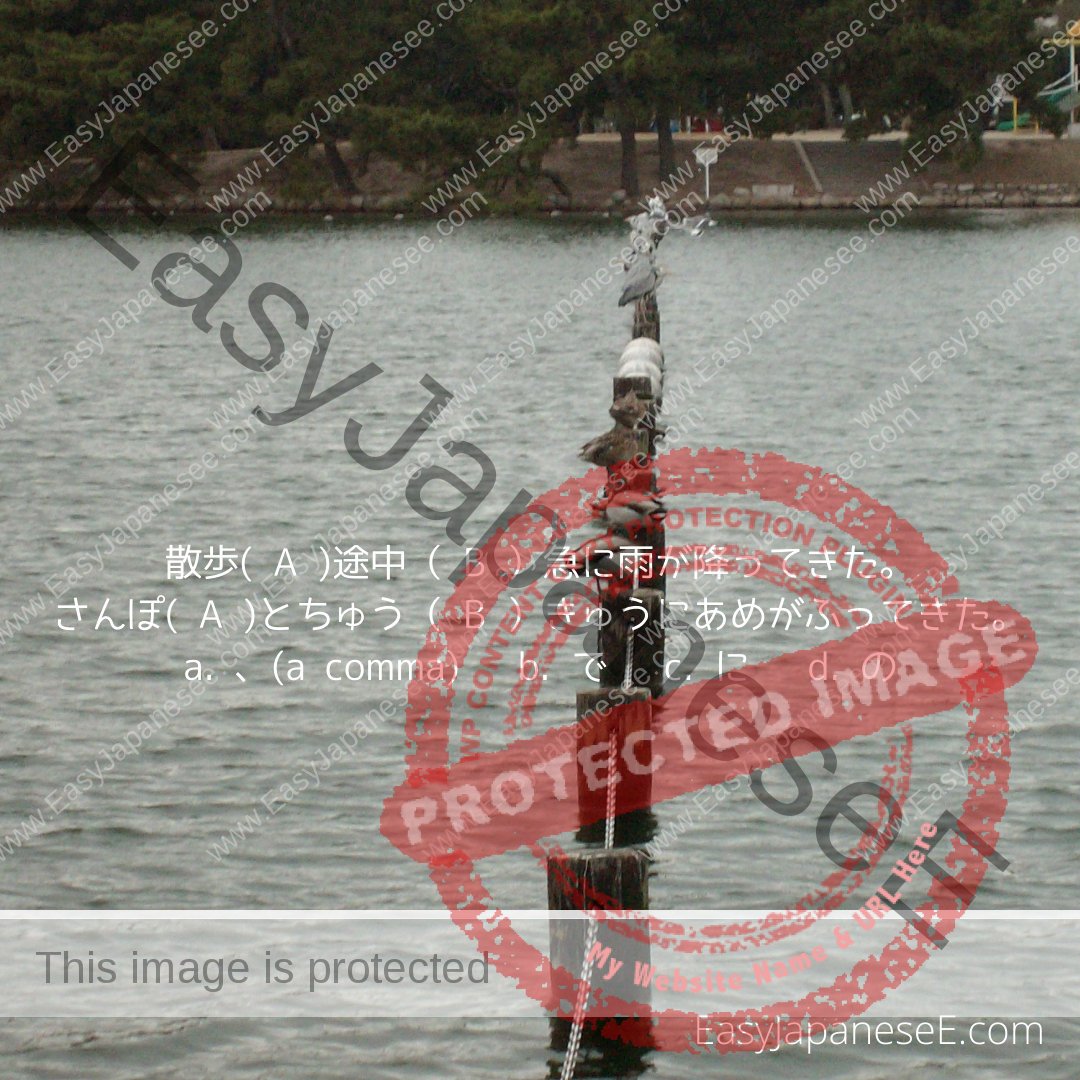
Today’s Question
散歩( A )途中( B )急に雨が降ってきた。
a. 、(a comma) b. で c. に d. の
Today’s Grammar Point: ~とちゅう
途中 is a noun which refers to a point between the starting point and the ending point. It can be a location or a time, or you can use it for “in the middle of something” like reading a book or making something. Having used the word “middle,” 途中 does not necessarily mean “half-way.” Although we are likely to use different expressions if we are talking about the beginning or towards the end of a process, 途中 can be any point during a process.
途中 can be used with or without a word preceding it but as it is a noun, it is followed by a variety of particles or a comma. Examples below have an explanation for the particle following 途中.
Connection
- as it is
- [noun] のとちゅう
- [dictionary form verb] とちゅう
- [てform verb] いる とちゅう
Examples
(シドニーに行くつもりだったが、)途中から引き返した。
(I intended to go to Sydney, but) I turned back halfway.
( 途中 is the starting point when I decided to go back.)
≒(シドニーに行くつもりだったが、) 途中で引き返した。
(I intended to go to Sydney, but) I turned back on the way.
( 途中 is the place of action of “turning back”)途中までお見送りします。
I will see you off halfway.
( 途中 is the ending point of my sending off.)車酔いしたので、 途中のバス停で降りた。
I got motion sick, so I got off at the bus stop on the way.
( 途中 is the attribute of the bus stop I got off the bus.)車酔いしたので、 途中でバスを降りた。
I got motion sick, so I got off the bus on the way.
( 途中 is the place of action of getting off the bus.)この記事は長いので、 途中を飛ばして読んでも構いません。
This article is long, so you can skip bits in the middle.
( 途中 is the object of the verb “to skip.”)学校に行く途中にパン屋がある。
There is a bakery on the way to school.
( 途中 is the place of existence.)
途中で or 途中に
I think most learners would find choosing 途中で or 途中に difficult. To beginners I say:
で: a place of action marker
に: a place of existence marker.
However, both 途中で and 途中に can be used with an action like:
話の途中で泣き出した。
話の途中に泣き出した。
These both mean “I/someone started to cry in the middle of a conversation” and they are both correct sentences.
To explain the difference here, I would say:
で refers to a precise point of an action
に describes a range of time or location when/where something happened
Thus
途中で emphasises the action that happens/happened
途中に emphasises the situation when the action happens/happened.
So, depending on the particle, the emphasis changes, which is shown in bold:
話の途中で泣き出した。
I/someone started to cry in the middle of a conversation.
話の途中に泣き出した。
I/someone started to cry in the middle of a conversation.I bought some bread on the way to school.
学校に行く途中でパンを買った。
I bought some bread on the way to school.
学校に行く途中にパンを買った。
I bought some bread on the way to school.
In the above examples, the differences are not that big but in the following situations, the latter sentence will convey the perceived trouble more clearly because the timing described is one of the worst time to have such an incident.
I wanted to go to the bathroom during the test.
テストの途中でトイレに行きたくなった。
テストの途中にトイレに行きたくなった。My passport expired during the trip.
旅の途中でパスポートの期限が切れた。
旅の途中にパスポートの期限が切れた。There was a power outage while baking the cake.
ケーキを焼いている途中で停電になった。
ケーキを焼いている途中に停電になった。
Having said all of this, in conversation, we often skip で or に. So, if you are not sure, just put a pause after 途中 in conversation or put a comma in a casual writing.
Answers to Today’s Question:
for A, d. の
for B, any of a, b. or c.
If you liked this post, please share it with your friends via your social media accounts. Your support will be appreciated!
For more JLPT N3 grammar items, please visit my JLPT N3 Grammar page.

